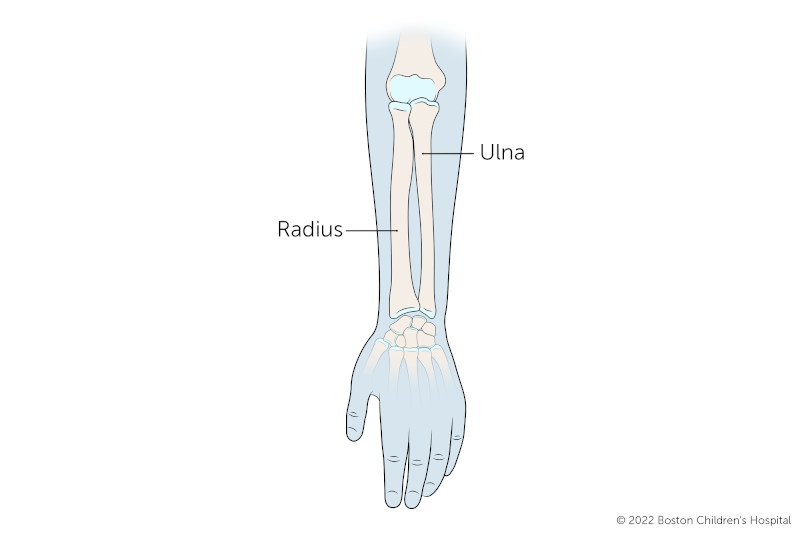Broken Forearm | Symptoms & Causes
What are the symptoms of broken forearms in children?
- arm pain that gets worse with wrist or elbow movement
- pain or swelling in the forearm, wrist, or hand
- a noticeable abnormality, such as bent arm or wrist
- difficulty using or moving the arm normally
- warmth, bruising, or numbness in the forearm or wrist
- numbness in the hand
What causes broken forearms in children?
A bone breaks when there’s more force applied to the bone than it can withstand. Childhood broken forearms can be caused by:
- Falls: Falling onto the bony tip of an elbow is the most common cause of forearm fracture.
- Trauma: A direct blow against a child’s forearm (for example, as a result of a car or bike accident) can cause a break in one or both of the bones in the forearm.
- Sports injuries: Many broken forearms occur as a result of mild to moderate (rather than severe) trauma that happens while children are playing or participating in sports.
Broken Forearm | Diagnosis & Treatments
How are broken forearms in children diagnosed?
To diagnose broken forearms in children, the doctor will carefully examine the injured area for tenderness, redness, and swelling.
One or more of the following imaging techniques may also be used to get detailed pictures of the broken bone and to check for damage to muscles or blood vessels.
X-ray
An x-ray of the arm is the main tool used for diagnosing a broken bone. This painless test uses small amounts of radiation to produce images of bone onto film. After the doctor puts the pieces of the broken bone in the right position, an x-ray can also help determine whether the bones in the arm are healing in the proper position.
Magnetic resonance imaging (MRI)
An MRI is a diagnostic procedure that uses a combination of large magnets, radio frequencies, and a computer to produce detailed images of organs and structures within the body. These types of tests are more sensitive than x-rays and can pick up smaller fractures before they get worse.
Computed tomography scan (CT, CAT scan)
A CT (or CAT) scan is a diagnostic imaging procedure that uses a combination of x-rays and computer technology to produce cross-sectional images (often called slices), both horizontally and vertically, of the body.
How are broken forearms in children treated?
Treatment for a broken forearm depends on the severity of the injury. The goal of treatment is to put pieces of the bone back in place and keep the pieces in the correct position while the bone heals.
Surgical options
Surgery may be needed to put broken bones back into place. A surgeon may insert metal rods or pins located inside the bone (internal fixation) or outside the body (external fixation) to hold bone fragments in place to allow alignment and healing. This is done under general anesthesia.
Treatment without surgery
- Traction corrects broken or dislocated bones by using a gentle and steady pulling motion in a specific direction to stretch muscles and tendons around the broken bone. This allows the bone ends to align and heal, and in some cases, it reduces painful muscle spasms.
- Closed reduction is a nonsurgical procedure used to reduce and set the fracture. Using an anesthetic (typically given through an IV in the arm), the doctor realigns the bone fragments from outside the body and holds it in place with a cast or splint.
Casts and splints
Splints and casts immobilize the injured bone(s) to promote healing and reduce pain and swelling. They are sometimes put on after surgical procedures to ensure that the bone is protected and in the proper alignment as it begins to heal.
- Splints are used for minor breaks. Splints support the broken bone on one side and immobilize the injured area to promote bone alignment and healing. Splints are often used in emergency situations to hold a joint in a steady position during transportation to a medical facility.
- Casts are stronger than splints and provide more protection to the injured area. They hold a broken bone in place while it heals by immobilizing the area above and below the joint. For example, a child with a forearm fracture will have a long arm cast to immobilize the wrist and elbow joints.
Some common types of casting for broken forearms include:
- short arm cast
- applied below the elbow to the hand
- used after forearm or wrist fractures; also used to hold the forearm or wrist muscles and tendons in place after surgery
- long arm cast
- applied from the upper arm to the hand
- used after upper arm, elbow or forearm fractures; also used to hold the arm or elbow muscles and tendons in place after surgery
- arm cylinder cast
- applied from the upper arm to the wrist
- holds the elbow muscles and tendons in place after a dislocation or surgery
How we care for broken forearms
You can have peace of mind knowing that the skilled experts in our Orthopedics and Sports Medicine Department's Hand and Orthopedic Upper Extremity Program have treated thousands of babies and children with many arm conditions. We provide expert diagnosis, treatment, and care, and we benefit from our advanced clinical and scientific research.
Broken Forearm | Research & Clinical Trials
The Orthopedic Clinical Effectiveness Research Center (CERC) at Boston Children's Hospital helps coordinate research and clinical trials to improve the quality of life for children with musculoskeletal disorders. This collaborative clinical research program is unique in the nation and plays an instrumental role in establishing — for the first time — evidence-based standards of care for pediatric orthopedic patients throughout the world.
Major areas of focus for the CERC include:
- trauma/fractures
- hip disorders
- upper extremity disorders
- spinal disorders
- brachial plexus birth palsy
Ongoing laboratory studies include:



